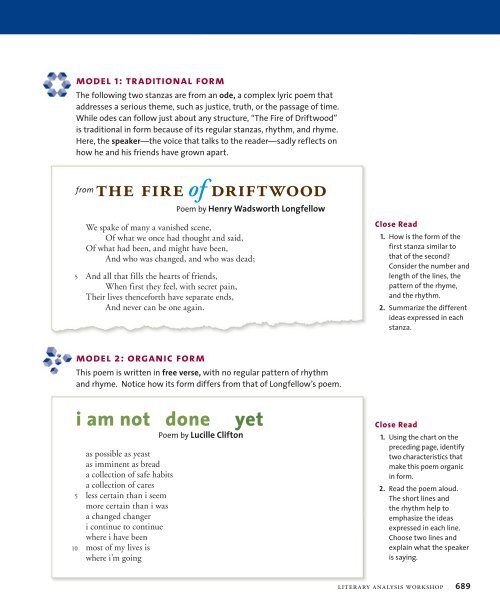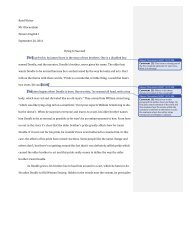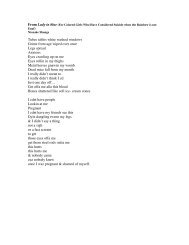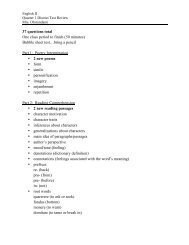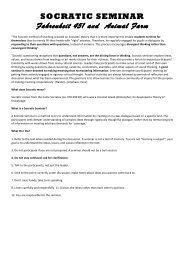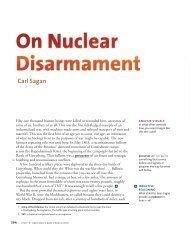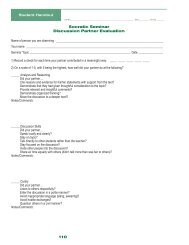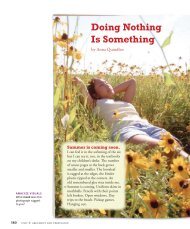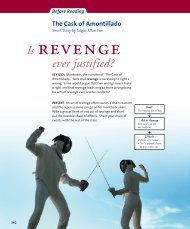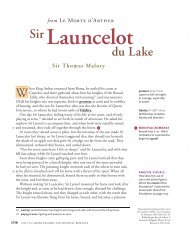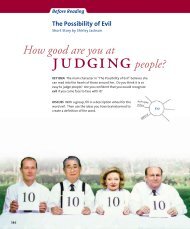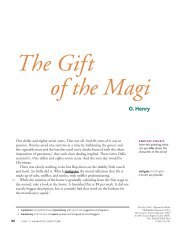The Language of Poetry - LanguageArts-NHS
The Language of Poetry - LanguageArts-NHS
The Language of Poetry - LanguageArts-NHS
Create successful ePaper yourself
Turn your PDF publications into a flip-book with our unique Google optimized e-Paper software.
model 1: traditional form<br />
<strong>The</strong> following two stanzas are from an ode, a complex lyric poem that<br />
addresses a serious theme, such as justice, truth, or the passage <strong>of</strong> time.<br />
While odes can follow just about any structure, “<strong>The</strong> Fire <strong>of</strong> Driftwood”<br />
is traditional in form because <strong>of</strong> its regular stanzas, rhythm, and rhyme.<br />
Here, the speaker—the voice that talks to the reader—sadly reflects on<br />
how he and his friends have grown apart.<br />
from the fire <strong>of</strong> driftwood<br />
Poem by Henry Wadsworth Longfellow<br />
5<br />
We spake <strong>of</strong> many a vanished scene,<br />
Of what we once had thought and said,<br />
Of what had been, and might have been,<br />
And who was changed, and who was dead;<br />
And all that fills the hearts <strong>of</strong> friends,<br />
When first they feel, with secret pain,<br />
<strong>The</strong>ir lives thenceforth have separate ends,<br />
And never can be one again.<br />
model 2: organic form<br />
This poem is written in free verse, with no regular pattern <strong>of</strong> rhythm<br />
and rhyme. Notice how its form differs from that <strong>of</strong> Longfellow’s poem.<br />
i am not done yet<br />
Poem by Lucille Clifton<br />
5<br />
10<br />
as possible as yeast<br />
as imminent as bread<br />
a collection <strong>of</strong> safe habits<br />
a collection <strong>of</strong> cares<br />
less certain than i seem<br />
more certain than i was<br />
a changed changer<br />
i continue to continue<br />
where i have been<br />
most <strong>of</strong> my lives is<br />
where i’m going<br />
Close Read<br />
1. How is the form <strong>of</strong> the<br />
first stanza similar to<br />
that <strong>of</strong> the second?<br />
Consider the number and<br />
length <strong>of</strong> the lines, the<br />
pattern <strong>of</strong> the rhyme,<br />
and the rhythm.<br />
2. Summarize the different<br />
ideas expressed in each<br />
stanza.<br />
Close Read<br />
1. Using the chart on the<br />
preceding page, identify<br />
two characteristics that<br />
make this poem organic<br />
in form.<br />
2. Read the poem aloud.<br />
<strong>The</strong> short lines and<br />
the rhythm help to<br />
emphasize the ideas<br />
expressed in each line.<br />
Choose two lines and<br />
explain what the speaker<br />
is saying.<br />
literary analysis workshop 689


